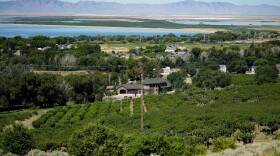-
Justen Smith, state Director of Extension Agriculture, warns that development of farmland threatens Utah's agricultural legacy.
-
We revisit our conversation from November 2017 with author Ted Genoways about his book "This Blessed Earth: A Year in the Life of an American Family Farm."
-
Farmers and market gardeners from around the state gathered to hear Extension agents present their latest tips and tricks for agricultural production.
-
Tagge’s Famous Fruit and Veggie Farms has placed its 130 acres into a trust to keep its farmland for future generations.
-
USU Extension's IMP Specialist Marion Murray is back in studio sharing some tips on combating grasshoppers for the summer season.
-
Recent increases in deportation rates have caused some farms to consider the agricultural worker program known as the H2-A in hopes of minimizing immigration raids.
-
Baby Animal Days at the American West Heritage Center gives families a chance to meet newborn animals and experience a bit of farm life.
-
Part cultural history, part memoir, and part elegy, “Weeds” reminds us that in losing our attachment to the land we also lose some of our humanity and something at the heart of our identity as a nation.
-
A key part of combating climate change is reducing harmful emissions from meat production on so-called factory farms. One group is calling for tougher regulations to cut the amount of emissions.
-
The U.S. Department of Agriculture is spending $60 million to help tribal farmers in the Mountain West use less water amid drought – and still grow their crops.

Play Live Radio
Next Up:
0:00
0:00
Available On Air Stations










